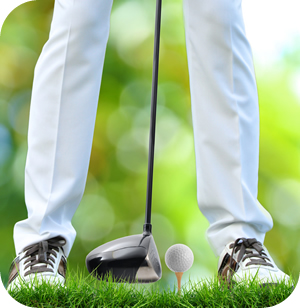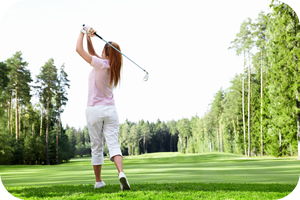Treating Golfer’s and Tennis Elbow with ART
Golfer’s Elbow
Golfer’s Elbow (Medial Epicondylitis) refers to the pain and inflammation that occurs at the inside point of the elbow (medial epicondylitis).
Golfer’s Elbow can be caused by any activity (not just golf) that requires forceful and repeated bending of the wrist and fingers. For example: when the golfer swings his club, the flexor muscles and tendons of the arm tighten just before the club makes contact with the ball. This repeated action stresses the muscles, causing micro- tearing of the flexor tendon, and inflammation of the soft-tissues. RSI problems occur when these muscles and tendons continue to be re-injured while the small tears are still in the process of healing. These new injuries cause the body to lay down additional adhesive scar tissue between the muscle layers in an attempt to stabilize the affected soft-tissues.
This adhesive scar tissue forms attachments to adjacent layers of tissue and structures, and inhibits the normal movement or translation of these soft-tissue structures. This lack of smooth movement causes friction and generates an ongoing cycle of inflammation and scar tissue formation.
Elbow injuries often require the practitioner to address a much bigger picture than just the elbow area. Symptomatically, what initially appears to be an elbow injury may actually be the result of poor core stability and lack of strength. This requires treatment of a much larger kinetic chain than just the elbow.
The Kinetic Chain of Golfer’s Elbow
 The game of golf emphasizes one-sided activity of the body; you are either a right-handed golfer or a left-handed golfer. This unilateral focus is the cause of numerous injuries as golfers tend to develop muscle imbalances which cause a wide array of myofascial restrictions.
The game of golf emphasizes one-sided activity of the body; you are either a right-handed golfer or a left-handed golfer. This unilateral focus is the cause of numerous injuries as golfers tend to develop muscle imbalances which cause a wide array of myofascial restrictions.
Golf, in its ideal form, is all about efficiently storing and releasing energy from your core out into your extremities. The classic golf swing engages your entire kinetic chain from your feet which form a solid stance, up through your hips and core, to finally release energy through your shoulders and arms right into the club head. This is much like a coiled spring, storing energy, then suddenly releasing it.
Unfortunately, for most golfers, this “coiled spring” is either broken or functions only minimally. Many golfers find that in the game of Golf, much of their energy and focus is spent on learning how to compensate for muscle imbalances, poor posture, and the multitude of myofascial restrictions that have developed over time.
Many patients who come to our clinic suffering from Golfer’s Elbow, also show these other common problems:
- Rounded shoulders (anterior posture).
- Restriction in the neck and low back (hypertonic or tight muscles with numerous trigger points).
- Tight restricted hips which are causing abnormalmotion patterns.
- Poor balance.
The Problem with Abnormal Motion Patterns
 A tight muscle on one side of your body almost always creates muscle imbalances, which in turn initiates a cascade of other events.
A tight muscle on one side of your body almost always creates muscle imbalances, which in turn initiates a cascade of other events.
First, these muscle imbalances result in abnormal motion patterns, which then cause the body to compensate by using other structures to perform the required action.
These abnormal motion patterns result in increased friction between tissues layers, with the friction creating micro-tears in your muscles. The micro-tears induce increased inflammation and the eventual formation of scar-tissue.This scar tissue inhibits motion. Inhibitions in motion result in numerous additional compensations throughout the body, initiating yet another ongoing cycle of dysfunction.
In the case of a golfer, a restriction in the hips often causes the golfer to over-compensate with their shoulders during a golf swing. Over time, this over-compensation creates restrictions in that shoulder, along with a corresponding alteration in posture. This in turn leads to a cascading series of injuries and restrictions along the entire kinetic chain.
Tennis Elbow
 Tennis Elbow is a painful condition at the outside point of the elbow that typically involves inflammation and irritation of the extensor tendon where it attaches to the lateral epicondyle.
Tennis Elbow is a painful condition at the outside point of the elbow that typically involves inflammation and irritation of the extensor tendon where it attaches to the lateral epicondyle.
The injury process for Tennis Elbow (lateral epicondylitis) is identical to that of Golfer’s Elbow (medial epicondylitis). However, for Tennis Elbow, the pain manifests on the outside point of the elbow.
Tennis Elbow involves the extensors (the muscles that bend the wrist back). The extensors attach to the lateral epicondyle, on the outside of the elbow. The common extensor tendon also attaches to the lateral epicondyle. Both these structures are susceptible to micro-tears when they are exposed to repetitive actions.
As with Golfer’s Elbow, Tennis Elbow (Lateral Epicondylitis) can be caused by a variety of activities. Any activity that involves excessive supination (turning the hand, palm side up) and pronation, or lifting objects with your elbow in full extension (elbow straight) can cause this condition.
The repetitive motions of these activities result in the formation of micro-tears, inflammation, scar tissue, and physical restrictions which then manifest as Tennis Elbow. In addition to the layers of soft-tissue that surround the elbow, practitioners should also consider the numerous kinetic chain relationships when attempting to resolve this condition. Some of the affected structures are near the elbow while others are quite distant. Several layers of soft-tissues are typically involved in this injury, including:
- The deep annular ligament.
- The supinator and anconeus muscles.
- The superficial structures of the extensor muscles.
- The fascia that surrounds and penetrates through all these areas.
In most cases, both Golfer’s Elbow and Tennis Elbow can easily treated with Active Release Techniques. This is especially true if the practitioner applies a kinetic chain perspective to locate and treat ALL the affected structures.
The key point is to find all the affected structures and then treat each affected structure as needed. This type of treatment requires a high level of tactile sensitivity by the practitioner. Equally important for full recovery, the patient should carry out specially designed exercise routines that focus upon all the structures of the affected kinetic chain.
If you would like more information or to purchase our books please go to www.releaseyourbody.com.
If you would like information about our clinic in Calgary Alberta please go to www.kinetichealth.ca.
(COPYRIGHT KINETIC HEALTH 2012 – ALL RIGHTS RESERVED)


Leave a Reply